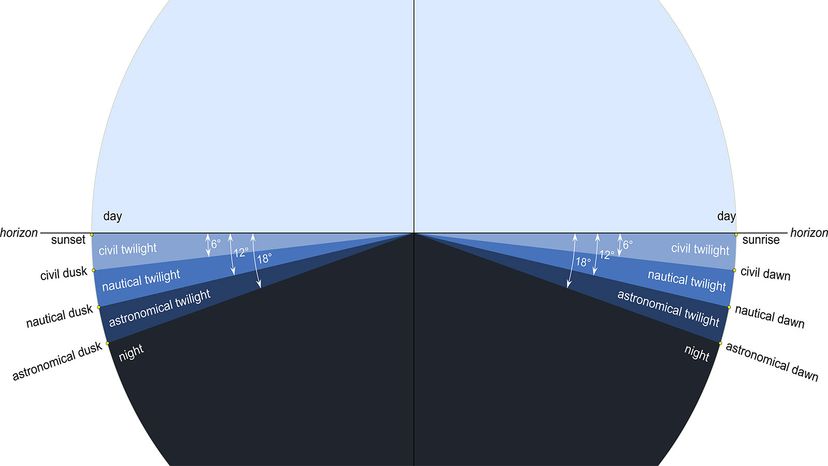
As you watch a setting sun, you see the sky go darker. Some people call that period "dusk," while others may call it "twilight." But these words aren't arbitrary in the astronomical world. They have specific meanings. In fact, astronomers have classified three types of twilight, dusk and dawn. Here's what they are and how you can tell them apart:
Advertisem*nt
Contents
- The Three Types of Twilight
- What's the Difference Between Each Type of Twilight?
- Twilight vs. Dawn or Dusk
The Three Types of Twilight
The three twilight types are civil, nautical and astronomical twilight. Civil twilight is the brightest phase of twilight, while astronomical twilight is the darkest, and occurs just before or after night.
The phases of twilight occur in the same order anywhere on Earth, but how long they last is based on your location on Earth.
Advertisem*nt
- Civil twilight occurs when the sun is between 0 degrees and 6 degrees below the horizon.
- Nautical twilight occurs when the sun is between 6 degrees and 12 degrees below the horizon.
- Astronomical twilight occurs when the sun is between 12 degrees and 18 degrees below the horizon.
- Night is classified when the sun is 18 degrees or farther below the horizon.
How long each phase lasts depends on the season and latitude you are viewing the sun from; each phase of twilight can be as short as 24 minutes (near the equator) or last several weeks if you are at or near one of the poles during the summer or winter months.
Advertisem*nt
What's the Difference Between Each Type of Twilight?
When most people say it's twilight, they are referring to civil twilight, the first phase of twilight that occurs just before sunrise or after sunset. At this point, the sun is barely below the horizon and there is still a good amount of light in the sky. Many countries and cities set laws based on this stage of twilight, such as requiring streetlights and headlights on cars to turn on.
Unfortunately, there is no hard-and-fast rule for telling the difference between each type of twilight, but here are some guidelines:
Advertisem*nt
One technique is to determine how well you can distinguish shapes in the dark. Obviously, we know when the sun breaks above or dips below the horizon, the time just before or after that is civil twilight. When the horizon itself becomes difficult to distinguish, that indicates you're in nautical twilight. The term dates back to mariners navigating the world by ship (after the sun dips below 12 degrees, a sailor can't usually distinguish between the sea and the sky). By astronomical twilight, the darkness is almost complete: The sky is an inky black, and it's hard to distinguish any shapes at all unless the moon is lighting up the night.
Another technique is to note the stars you can see. In civil twilight, only the brightest stars and visible planets can be seen. It becomes increasingly easy to spot stars through nautical twilight until astronomical twilight when even the faintest stars can be seen. Astronomical twilight is also the earliest phase you can easily see the Milky Way.

Advertisem*nt
Twilight vs. Dawn or Dusk
While we often use the terms "dawn," "dusk" and "twilight" interchangeably depending on the time of day, both dawn and dusk have specific astronomical meanings. There are actually three types of dawn and three types of dusk.
- Civil dusk occurs when the sun is exactly 6 degrees below the horizon in the evening.
- Nautical dusk occurs when the sun is 12 degrees below the horizon.
- Astronomical dusk occurs when it is 18 degrees below the horizon.
Conversely, civil, nautical, and astronomical dawn occur when the sun is at those respective degrees below the horizon before sunrise. In other words, dawn and dusk occur when the sun passes a specific point below the horizon (for instance 18 degrees), while twilight refers to the phase between those points (for instance between 12 and 18 degrees).
Advertisem*nt
The next time you are out enjoying a beautiful sunrise or sunset, take a minute to consider which of the three phases of dawn/dusk or twilight you might be experiencing!
Now That's Interesting
To get a sense of how far 6 degrees increments are in the sky, you can use your hand. By holding your arm straight out and putting three fingers up from your closed fist, the distance from one side of your fingers to the other is roughly 5 degrees.
Advertisem*nt
Frequently Asked Questions
How does the location of an observer affect the experience of twilight and dusk?
Near the equator, twilight phases are shorter, leading to a quicker transition from daylight to darkness. At higher latitudes, especially near the poles, twilight can last for several hours due to the shallow angle of the sun's path relative to the horizon.
What role do atmospheric conditions play in the visibility of stars during twilight?
Factors such as humidity, air pollution and atmospheric instability can contribute to haze or distortion in the atmosphere, impacting star visibility by reducing contrast and clarity.